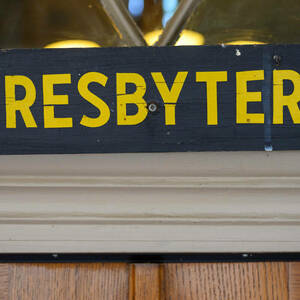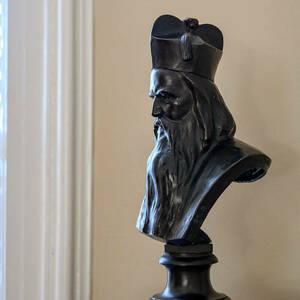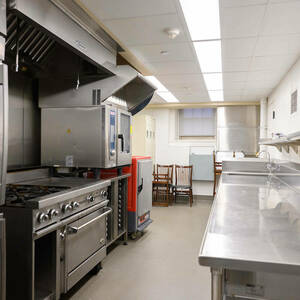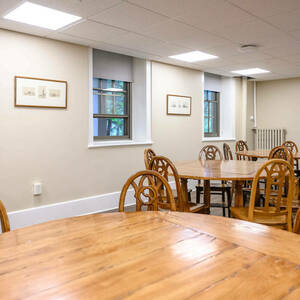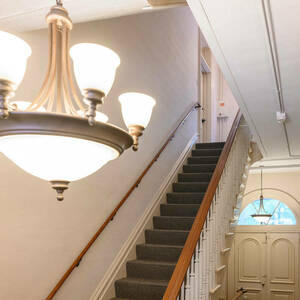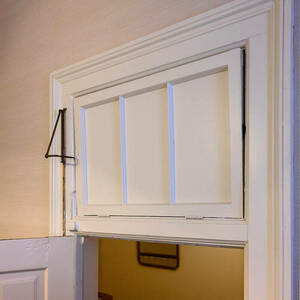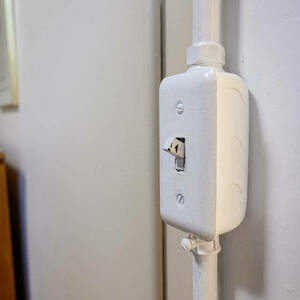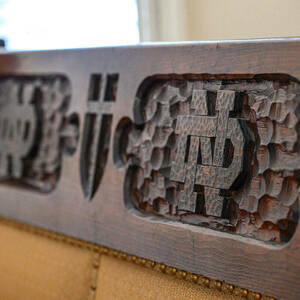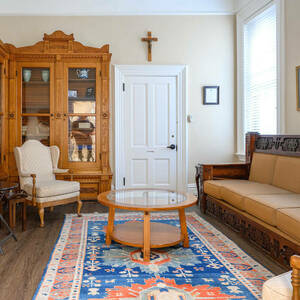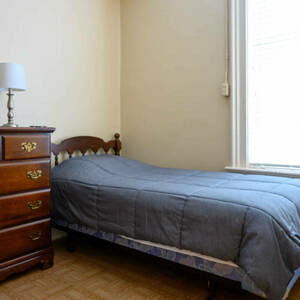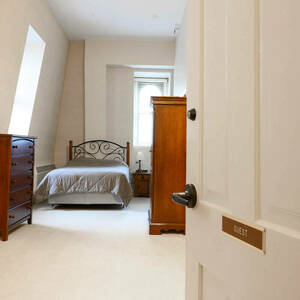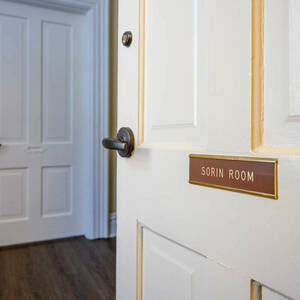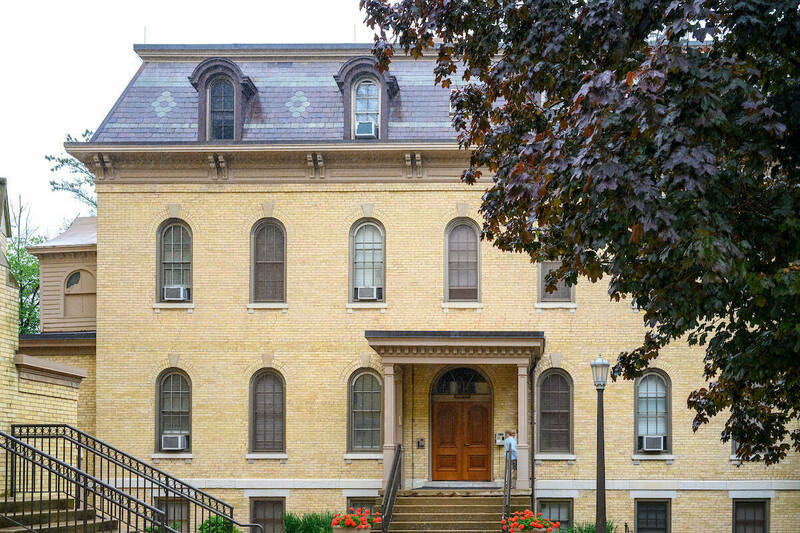 Photography by Matt Cashore ’94
Photography by Matt Cashore ’94
Tucked on a hill above the Grotto and behind the Basilica of the Sacred Heart, the yellow brick building often goes unnoticed.
The Presbytery’s unassuming exterior, mansard roof and tall arched windows are a nod to Notre Dame’s French roots. Just off Main Quad, the boxy structure has stood witness to nearly 150 years of the University’s history.
Over time, it has served as the home and office for the Congregation of Holy Cross provincial superior and the Sacred Heart Parish pastor, base for the editor of The Ave Maria magazine (which ceased publishing in 1970), and as a residence for countless Holy Cross and other priests on the faculty.
The building these days has no full-time residents. It serves as a guest house for visiting friends and relatives of Congregation of Holy Cross members. It offers 12 guest rooms, each with an in-suite bathroom and some with small living rooms. The guest rooms are homey and serviceable, but not luxurious.
“Quite often it’s booked every day in the fall. Rarely is it empty,” says Rev. Robert Dowd, CSC, ’87, a Notre Dame vice president and associate provost, and religious superior of the Holy Cross community on campus.
Although some sources date the Presbytery to 1869, news articles from the era pinpoint its construction in the early 1870s. Completed in about 1874, it is one of the oldest buildings still standing on campus. Old College was built in 1843 and a small section of Columba Hall may also predate the Presbytery. Sacred Heart Church — now the Basilica of the Sacred Heart — was under construction from 1870 to 1888. (Brownson Hall, built about 1855, was demolished in 2020 and replaced with Remick Family Hall.)
A presbytery is a residence for priests. It has also at times been referred to as the provincial house, the residence of the superior general or the rectory. For many years, the Sacred Heart parish center was based in the building — until 1992, when it moved to a former seminary building on the north shore of St. Joseph’s Lake.
In 1865, Notre Dame founder Rev. Edward Sorin, CSC, became the first American provincial superior of the Congregation of Holy Cross, and in 1868 was named the Congregation’s superior general. In 1870, the local council approved the building of a residence for the superior general, Rev. Thomas E. Blantz, CSC, ’57, ’63M.A., recounts in his book, The University of Notre Dame: A History.
Construction was underway three years later, according to Scholastic magazine. “The foundations of the Provincial house, facing the lower lake, are laid,” the magazine reported in August 1873. By the next month, the building’s brickwork had risen to the second story. The completed structure would be three stories, plus a full basement.
By June 1874, the house had received its cornice. “We understand that Father General’s house will be tenable by Commencement and will be occupied by visitors,” Scholastic reported.
Final details took a while. “Work on Father General’s new house still continues — and keeps on continuing,” Scholastic reported in October 1874.
The rear wooden veranda was added in summer 1877. Vintage photos also show a sun porch — no longer there — on the building’s south side.
An 1878 written reference to the building found in the Notre Dame Archives described the Presbytery as “new, large and commodious, with 10 double rooms and three larger rooms for exercise, recreation and meals.”
The Presbytery was designed by William Thomas, a Chicago architect also responsible for the six-story, French-style second Main Building, completed in 1868. That building was destroyed in the Great Fire of 1879 and replaced with the current Main Building, topped with the landmark Golden Dome.
Rubble from the Great Fire was carted away and dumped in a marshy area just west of the Presbytery. That land eventually became the site of the Notre Dame Grotto, completed in 1896.
A visit inside the Presbytery today reveals sturdy construction with few architectural embellishments. The interior features a standard Victorian-era layout with a steep central staircase, high ceilings and transom windows. There are dormer windows and a modern skylight on the extra tall top floor.
A stained-glass window on the second floor mentioned in an early Scholastic is no longer there. Gone too are a chapel, parlor and library referenced in early news reports.
Two large 19th-century walk-in safes that formerly stood in the Presbytery were removed a few years ago. The doors — with “Diebold Safe & Lock Co. Canton, O.” still visible in ornate lettering — are now part of the hallway decor on the ground floor of the new Corby Hall that opened in 2020.
Until three years ago, the Presbytery was still home to several priests. The building received a renovation and some upgrades in 2017 in order to serve as a temporary community center for Holy Cross priests while the new Corby Hall was under construction. Improvements include a full, commercial-style kitchen in the basement with seating for about 65.
There are no plans to demolish the Presbytery or make any major changes. “We’ll continue to use it as a guesthouse. We put it to good use,” Dowd says. “I would like to see some basic upgrades without destroying its character.”
The building has window air-conditioning units. It would be a welcome improvement to upgrade to central air if the walls allow for it, Dowd says.
Up the front steps, just inside the front door and to the left is the Sorin Room. Although the interior layout of the building has been altered over the years, it’s believed the space was part of Sorin’s small personal apartment. A bust of the founder today stands in a corner.
About two years before his death, Sorin was quite ill and confined to his rooms in the Presbytery, historian Rev. Arthur J. Hope, CSC, a 1920 graduate, wrote in an article published in the March 1942 edition of Notre Dame Alumnus magazine.
“As he lay in his reclining chair, he could turn his head and see, through the window, the golden dome and Our Lady surmounting it,” Hope wrote. “He scribbled a note in his shaky hand and addressed it to Father Thomas Walsh, C.S.C, the then president of the University. ‘This morning, I have been looking at Our Lady. I am now as certain as it is possible to be certain that with the aid of Our Blessed Mother, under whose image we are living, our University will prosper. There is only one obstacle, and that arises from ourselves. If we ever withdraw our confidence in her protection, or fail to do her will, then, indeed, the University will fall in ruins!’”
Sorin, age 79, died in his corner room in the Presbytery on October 31, 1893.
Margaret Fosmoe is an associate editor of this magazine. Contact her at mfosmoe@nd.edu or @mfosmoe.
